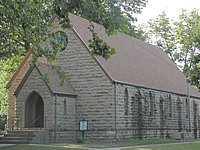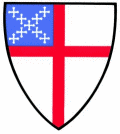
Again, off the beaten path a little, this time for the transcript of an interview on PBS with our new Presiding Bishop.
PAT
===============================
WEB EXCLUSIVE:
Interview with Bishop Katharine Jefferts Schori
June 21, 2006
RELIGION & ETHICS NEWSWEEKLY correspondent and program managing editor Kim
Lawton spoke to Presiding Bishop-Elect Katharine Jefferts Schori on June 20
in one of the first in-depth interviews the bishop has given since her landmark election. Excerpts from this conversation will be included in this week's edition
of the show (to be distributed Friday, June 23) as part of a larger story on the convention.
KIM LAWTON: You mentioned right away after your election that you saw the church as having an opportunity to be the vehicle for the reign of God. And I just wanted you to tell us a little bit more about what you see, what is that vision of the church?
Bishop KATHARINE JEFFERTS SCHORI (Presiding Bishop-Elect, U.S. Episcopal Church): Well, the church is a community that is really called to transform the world around it. That takes different forms in different places. Each one of us has got a piece to play in that kind of work. And the fact that this General Convention has adopted justice and peace as its first priority for mission in the coming triennium, particularly focused on the UN Millennium Development Goals, gives us an enormous opportunity to be part of building something that looks very much like the reign of God that's achievable in our own day.
LAWTON: Are you very mindful of the magnitude of what you are lurching into?
Bishop JEFFERTS SCHORI: Probably not fully. I'm sure that I will have much to learn that I don't even know about. But I think life is meant to be challenging. If we're going to use the fullness of the gifts that we've been given, it means we have to continue to be stretched. And I look forward to that.
LAWTON: What message does your election send to all the quarters of the Episcopal Church?
Bishop JEFFERTS SCHORI: This is not your grandmother's church anymore. When I was growing up, girls and women could only do things like sing in the choir and serve on the altar guild. And singing's not my great strength, so I had no concept of being active in leadership in the church when I was growing up.
LAWTON: And what about for the rest of the communion? What message, what signal do you hope this sends to other members of the Anglican Communion?
Bishop JEFFERTS SCHORI: I hope that our decisions at this General Convention send several messages to the rest of the communion: that we are incredibly anxious to be, to continue to be, part of the communion; that we are fully committed to partnerships across the globe; that we firmly believe that all people need to be included in the reign of God that is being built; that people of all colors and races and nations and language groups and sexual orientations are fully part of this creation that God has blessed us with.
LAWTON: What do you anticipate saying to some of the primates at your first meeting, including some that you know have problems with women being ordained? What can you imagine yourself saying to them?
Bishop JEFFERTS SCHORI: One would probably begin with "hello," to begin to build some kind of relationship, speaking about each other's contexts, who am I, where do I come from, what kind of history do I bring, what kind of theology do I understand that this church is being called to? And we cannot have substantive conversations until we know each other as human beings.
LAWTON: Some people say that this has been a real crucial time for the Anglican Communion just in terms of reexamining what Anglicanism means today in this world. Do you think that is going on right now?
Bishop JEFFERTS SCHORI: Yes it is, and I think it goes on in every age. Anglicanism has grown out of a history of struggle and tension. The great Elizabethan compromise that produced the Church of England was born out of incredible strife, but it has been a gift to many, many people around the globe.
LAWTON: And so in what way do you see, you know, what are some of the critical issues that global Anglicans need to be examining right now?
Bishop JEFFERTS SCHORI: We need to be examining the poverty that is real around the world. We need to be examining the fact that our brothers and sisters, Anglican and not, in places like Africa and Asia don't have enough to eat. Their children don't have the opportunity to go to school. AIDS and tuberculosis and malaria are rampant in many parts of this world and people with those diseases don't have access to adequate health care. That's where our focus needs to be.
LAWTON: Clearly, one of the big challenges, the big issue is the sexuality debates. What message do you hope that this convention sends to people who are very upset about the consecration of Gene Robinson and are really opposed to same-sex, the blessing of same-sex unions? What signal do you hope they get from this convention?
Bishop JEFFERTS SCHORI: That there is room for them at this table as well.
LAWTON: And what about for gay and lesbian members of the church who are concerned that maybe there is a backing away, that maybe they're being, in some way being called to make sacrifices for the sake of unity that aren't just, for a church that's emphasizing justice? What do you hope they hear from this?
Bishop JEFFERTS SCHORI: The same message, that there is room for them at this table as well, that God calls all of us to this bountiful table to share in the riches of creation that were given for all.
LAWTON: There've been some pretty pointed statements publicly from some of the conservative bishops and other leaders of that wing of the church, really raising questions about whether indeed everybody can stay at the table and whether this is a time when that is no longer possible. Do you feel that reconciliation is still possible, and what will you do to try and make that happen?
Bishop JEFFERTS SCHORI: Reconciliation is always possible. The Christian faith is about the eternity of hope. Once we give up hope, I think we cease to become active, engaged Christians. If we have no hope, we have repudiated the basis of our faith. There is always the possibility of reconciliation, resurrection, renewal. And once we lose a sense of that in a very deep way, we have challenged the very foundations of our faith. If -- if the resurrection, the reconciliation may come beyond the grave, but we insist that it is always possible.
LAWTON: Talk about the transition, oceanographer turned bishop. What led to that?
Bishop JEFFERTS SCHORI: Well, I knew I was supposed to go fishing, and it took me a while to figure out just what for. Christians often talk about being sent to fish for people; the gospel is about drawing all people into the reign of God. When it became apparent that I was not going to be able to continue to be an active oceanographer, that if I wanted to continue in the field it was going to be as a grants writer and hustling grant money, right at the very same time, three people in my congregation asked me if I'd ever thought about being a priest, just out of the blue. It seemed absurd, it seemed unfitting to the gifts that I recognized at the time. But I went and spoke at great length with the priest in that congregation and came to the conclusion that, at least, the time wasn't right. But five years later, I was asked to preach on a Sunday morning when he wasn't going to be there -- a new rector. And that experience and the response that I had to that experience finally let me say yes. And I was in seminary the next fall.
LAWTON: Describe some of your emotions on Sunday [the day she was elected the first female presiding bishop]. What gamut did they run?
Bishop JEFFERTS SCHORI: It was a long and challenging day -- to sit waiting, to recognize that this election might possibly call me into this office. I think we were all surprised, all of us.
LAWTON: And I have a personal question for you. Just, a lot of people have different practices to maintain their own spiritual spark, you know, and to maintain that, and I'm just wondering if you'd be willing to share what's most meaningful for you? How do you get your best connection with God?
Bishop JEFFERTS SCHORI: I've always found a great sense of spirituality in the out-of-doors. I ground myself as a creature in the midst of the natural created order. And taking Sabbath time is exceedingly important to me, taking time away, and I bring all of those together in seeking solitude in the wilderness. The wilderness is a place of great gifts. It may be threatening to some people; it ought to be threatening, I think, in some important way. But it is a place where I discover God, and what God is calling me to do and be.
http://www.pbs.org/wnet/religionandethics/
week942/exclusive.html
























